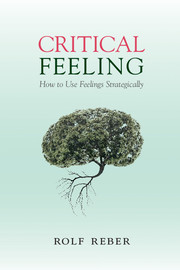Book contents
- Frontmatter
- Dedication
- Contents
- Preface
- Part I The basics of critical feeling
- Part II Applications of critical feeling
- 4 Happiness through critical feeling
- 5 The role of sensory and bodily feedback
- 6 Living together
- 7 Critical feeling in business and politics
- 8 Critical feelings at school
- 9 Music, art, and literature
- 10 Religion and morality
- Epilogue
- Notes
- References
- Index
9 - Music, art, and literature
from Part II - Applications of critical feeling
Published online by Cambridge University Press: 05 March 2016
- Frontmatter
- Dedication
- Contents
- Preface
- Part I The basics of critical feeling
- Part II Applications of critical feeling
- 4 Happiness through critical feeling
- 5 The role of sensory and bodily feedback
- 6 Living together
- 7 Critical feeling in business and politics
- 8 Critical feelings at school
- 9 Music, art, and literature
- 10 Religion and morality
- Epilogue
- Notes
- References
- Index
Summary
By nature, people are similar; they diverge as the result of practice.
(Confucius, Analects, §17.2, cited in Slingerland 2003b, p. 200)The previous chapter emphasized the role of feelings when children learn at school, among them the role of beauty in judging a solution as true and the aesthetic quality of an aha-experience. When we think of aesthetics, we think of art. It amounts to common sense that aesthetic experiences may go beyond art and pertain to such different topics as beauty in nature, the attractiveness of a face, the melody of a foreign language, the arrangement of food on a plate, the elegance of a mathematical proof, or the sound of an engine. By contrast, art is often equated with aesthetics. This is a mistake made by many scholars and laypeople alike (see Carroll 1999; Danto 2003) and has been called the artistic–aesthetic confound (Bullot and Reber 2013b). The whole field of neuroaesthetics discusses its findings as if they could be applied to art in general. In a famous article, Ramachandran and Hirstein (1999) listed eight laws of artistic experience. The title of the article is “The Science of Art: A Neurological Theory of Aesthetic Experience” – as if aesthetics and art were interchangeable. This led to a narrow view of art as yielding aesthetic pleasure. In order to examine art appreciation, researchers in empirical aesthetics used the artwork as a stimulus and mainly used liking or aesthetic pleasure as dependent variables (see Bullot and Reber 2013a for a critique). We shall see that art appreciation consists of both understanding and evaluation, and that understanding depends on knowledge about the context in which the artwork has been created. Even an aesthetic theory of art (see Carroll 1999 for an overview) would have to consider understanding based on the art-historical context.
This chapter outlines critical feeling in art appreciation. Art encompasses the visual arts, literature, drama, poetry, music, dance, and architecture. This chapter begins with a review of how people interested in music develop certain tastes and continues with two ways of learning artistic styles. I next summarize the psycho-historical framework of art appreciation, which helps us to deal with the alienation effect, and connect ideas by the German playwright Bertolt Brecht to the most recent findings from cognitive psychology.
- Type
- Chapter
- Information
- Critical FeelingHow to Use Feelings Strategically, pp. 199 - 215Publisher: Cambridge University PressPrint publication year: 2016



